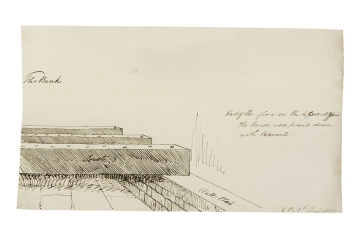
Browse
Reference number
Purpose
Aspect
Inscribed
Signed and dated
- (12) CP- 8th Decr. 1817
Hand
Notes
Drawing 12 shows the wooden joists which formed the structure on which the floor surface was laid. The 'trennels' refered to in the inscription are described in The Dictionary of architecture as 'Trenail' or 'Trennel', 'A cylindrical pin of wood, of a length proportionate to its duty, used in securing the pieces in timber framing: and used in situations where iron bolts are considered objectionable'.
Drawing 12 appears to be inscribed with the initials 'CP', which would suggest that the drawing were made by Charles Edward Papendick (1801-1835). However, Bolton records that Papendick did not begin as a pupil in Soane's office until 4 March 1818 (the drawing is dated 8 December 1817). On the other hand, the day book for December 1817 records that H. Parke (1790-1835, pupil 1814-1820) made several drawings of the Bank around this time (see also notes to drawing 15).
Literature
Level
Sir John Soane's collection includes some 30,000 architectural, design and topographical drawings which is a very important resource for scholars worldwide. His was the first architect’s collection to attempt to preserve the best in design for the architectural profession in the future, and it did so by assembling as exemplars surviving drawings by great Renaissance masters and by the leading architects in Britain in the 17th and 18th centuries and his near contemporaries such as Sir William Chambers, Robert Adam and George Dance the Younger. These drawings sit side by side with 9,000 drawings in Soane’s own hand or those of the pupils in his office, covering his early work as a student, his time in Italy and the drawings produced in the course of his architectural practice from 1780 until the 1830s.
Browse (via the vertical menu to the left) and search results for Drawings include a mixture of Concise catalogue records – drawn from an outline list of the collection – and fuller records where drawings have been catalogued in more detail (an ongoing process).




